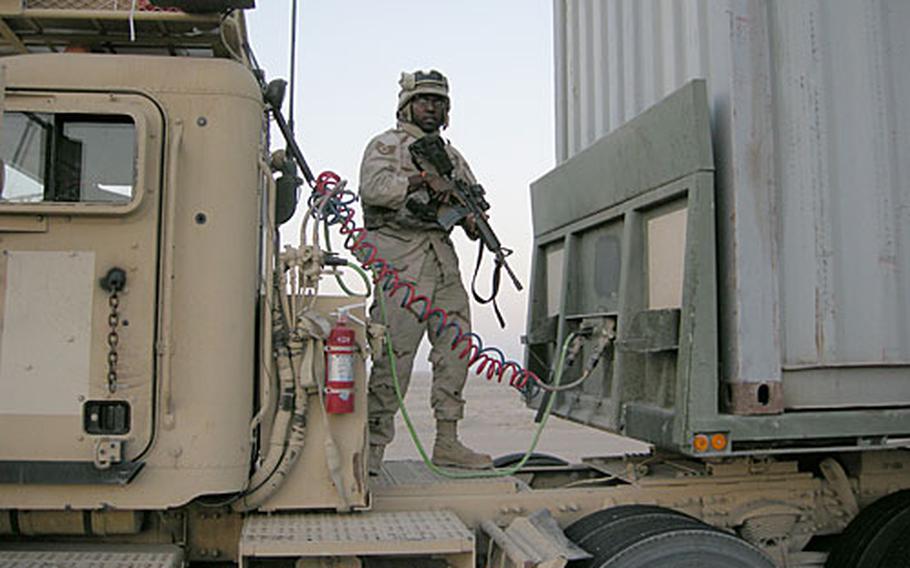
Staff Sgt. Brian Lee, of the 100th Logistics Readiness Squadron at RAF Mildenhall, England, pulls security on top of a M915 tractor trailer during a mission in Iraq. (Photo courtesy of Staff Sgt. Brian Lee)
RAF MILDENHALL, England — Staff Sgt. Brian Lee knows all about going outside the wire in hostile terrain and the potential dangers that come with it.
The 100th Logistics Readiness Squadron airman recently returned from his third tour in Iraq, where he spent six months racking up 11,700 miles in convoy missions running supplies from Kuwait into the war-torn country.
On a deployment in 2005, he took part in a two-day Survival, Escape, Resistance and Evasion course at Balad Air Base, Iraq. He credits the training for making him more confident on his daunting missions.
“You may be put in a situation where you will have to use this training,” he said. “It was very real because every day we went outside the wire.”
The Air Force plans to usher in similar training early this summer for deploying airmen whose job fields, like Lee’s, put them in harm’s way.
The four-day course, announced last September, falls between the computer learning course required of all airmen and the full-blown, advanced field course — mostly reserved for aircrews and special operations personnel — that most airmen associate with SERE training.
Recently dubbed Evasion and Conduct After Capture, or ECAC, the course is a combination of classroom and role-play “hands-on” training, according to Air Education and Training Command spokesman Dave Smith.
The first ECAC class will be taught at Fairchild Air Force Base, Wash., home of the Air Force’s SERE school, starting in May or June. Fairchild’s 336th Training Group will write the curriculum and teach the first several ECAC classes in order “to get the bugs out,” Smith said.
Students in the maiden ECAC course will be preparing to deploy to Iraq or Afghanistan and “individuals identified as at the greatest risk of isolation,” according to Smith. He declined to be more specific, for security reasons.
Duties more dangerousLee, 33, of Miami, has never used his SERE skills in combat. However, there were situations where he may have had to.
When one of the unit’s vehicles gets a flat tire, for example, the convoy often continues, leaving the broken down vehicle behind for repairs, along with a security vehicle.
“You do get left out on your own,” Lee said.
He strongly agrees in the development of the ECAC course after what he witnessed in his deployments.
Other airmen agreed.
“It used to be that we were considered to be in the rear with the gear,” said Staff Sgt. Philip Harmon, a fuels distributor in Lee’s Mildenhall-based squadron. “That’s not happening much anymore. Guys are coming back with Purple Hearts.”
Harmon handles his unit’s computer-based SERE training, which takes about four hours to complete. He said the new course would be a good addition to the training regimen, more fully reaching the “hands-on learners.”
“I think combining the two would probably be the best way to hit as much people as possible, and allow them to grasp the whole concept,” said Harmon, who once delivered fuels throughout Afghanistan via a C-130 aircraft.
His co-worker, Staff Sgt. Adam Cox, has worked as a fuels distributor in Iraq, Kuwait and Qatar.
Cox admitted that he rarely left the confines of forward bases but did recall a 2004 incident when he and another airman were pursued through the streets of Kuwait City.
“One night we actually got tailed by an unknown assailant and it kind of turned into a high-speed chase,” said Cox, who added that they lost the driver at a busy intersection.
Cox was baffled about why the vehicle followed them, and the idea of being kidnapped snapped both of them into survival mode.
“If things had gone differently in that situation it would have definitely been nice to have that type of training, just in case,” he said referring to the ECAC course.
Asset for deploying airmenIn his modified SERE course in Iraq, Lee said he learned tactics on how to survive alone on the battlefield or when captured as a prisoner of war. He was also told of survival tips on what to eat, such as snakes and scorpions, to travel at night instead of the day and how to protect himself from the sun.
Although he has never been captured, Lee is very aware of the reality of becoming a prisoner of war.
In 1999, he was on a tour in Macedonia, working as a bodyguard for a NATO operation, when three U.S. soldiers were captured by Yugoslav forces. Lee met one of the soldiers two days before he was snatched in a disputed area near the border — an area that Lee often drove.
All three soldiers were eventually released, but it could have been a bleaker outcome.
“SERE training would be an excellent asset for anybody that deploys. You never know where [insurgents] are going to strike,” Lee said.